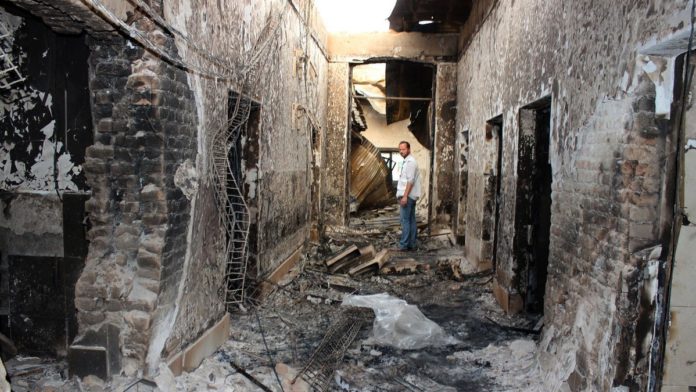U.S. gunship opened fire on Doctors Without Borders staff as they fled bombed hospital

A Doctors Without Borders report reveals an American gunship opened fire on the international humanitarian organization’s staff as they ran for their lives from its hospital in Kunduz moments after a deadly airstrike last month.
“Patients burned in their beds, medical staff were decapitated and lost limbs, and others were shot by the circling AC-130 gunship while fleeing the burning building,” reads the internal report, released on Thursday.
At least 30 people were killed in the attack, including staff members of the medical charity, commonly known by its French acronym, MSF.

An employee of MSF inside the charred remains of their hospital after it was hit by a U.S. airstrike in Kunduz, Afghanistan.
Image: Najim Rahim /Associated Press
Meinie Nicolai, MSF’s president in Brussels, the branch of the organization that oversaw operations in Kunduz, told Mashable by phone on Thursday that the comprehensive report of the bombing as it unfolded from inside the hospital, and of the events at the facility in the days ahead of the attack, proves a serious mistake was made in targeting it.
Nicolai said MSF interviewed 60 staff who were in Kunduz, “and we looked at phone records and emails to get a chronological account and to be completely transparent.”

A handout photo made available on Oct. 1, 2015, shows MSF members treating injured people in a hospital in Kunduz, Afghanistan, on Sept. 30, 2015.
Nicolai said the internal audit proves MSF had given coordinates to all parties, including the Afghan and American militaries, and that there was no evidence of armed combatants inside the facility or fighting happening in the immediate area around the hospital at the time of the attack.
The Army Green Berets who requested the Oct. 3 airstrike were aware it was a functioning hospital but believed it was under Taliban control, according to the Associated Press.

A satellite image shows the MSF hospital’s trauma center in Kunduz before the U.S. attack, on June 21, 2015.
Image: Doctors Without Borders/MSF

A satellite image shows the MSF hospital’s trauma center in Kunduz after the U.S. attack, on Oct. 8, 2015.
Image: Doctors Without Borders/MSF
The attacks were carried out before sunrise. The trauma center, or ICU, was hit first at 2 a.m., as staff were performing at least two surgeries. Two children were in the ICU.
Those staff and patients were directly killed in the first airstrikes or in the fire that engulfed the building as a result, said the report.
“Immobile patients in the ICU burned in their beds,” it read.
After hitting the ICU, the airstrikes then continued from the east to west end of the main hospital building.
“The ICU, archive, laboratory, ER, x-ray, outpatient department, mental health and physiotherapy departments as well as the operating theatres were all destroyed in this wave after wave of strikes,” the report said.

Patients burned in their beds and medical staff were decapitated and lost limbs during the attack.
Image: Victor J. Blue
Many MSF workers interviewed described massive explosions, “sufficient to shake the ground” and coming in concentrated volleys. One MSF staff member told of a patient in a wheelchair trying to escape from the inpatient department when shrapnel from a blast killed him.
MSF staff said they made several distress calls to both U.S. and Afghan officials during the attack. The first call was placed at 2:19 a.m. At 2:52 a.m., a reply was received by MSF in Kabul from Resolute Support saying, “I’m sorry to hear that, I still do not know what happened.”
Six minutes later, after hospital staff sent another message and insisted the attack stop, they were told, “I’ll do my best, praying for you all.”
The bombing lasted for more than an hour, ceasing at around 3:15 a.m. In the end, at least 30 people were killed, including 10 patients, 13 staff members and seven bodies burned beyond recognition.
The view from #Kunduz hospital is that attack was conducted with an aim to kill & destroy https://t.co/TA59r6uCP8 pic.twitter.com/6xi1wKM4Xl
— MSF International (@MSF) November 5, 2015
The bombing sparked an international outcry and investigations by the Pentagon and NATO.
But MSF would like an independent investigation into the event.
“We don’t have view from cockpit or from within Afghan & US chain of command. We need a #IndependentInvestigation,” the humanitarian group tweeted on Thursday.
We don’t have view from cockpit or from within the Afghan & US chain of command. We need a #IndependentInvestigation https://t.co/TA59r6uCP8
— MSF International (@MSF) November 5, 2015
Since the Kunduz bombing, a second MSF hospital in Yemen has been hit by coalition airstrikes.
Nicola emphasized that MSF operates under International Humanitarian Law (IHL), which clearly states that no medical staff can be punished or attacked for giving medical aid to someone, even combatants.
But some countries, like the U.S., have special rules of engagement, she notes. “If these rules of engagement are different and outside of IHL, then it needs to be clear and known,” she said. “If they can target a hospital, then we should be warned about this.”
“The rules of war seem to have become … disrespected,” she added.
The full MSF report can be found here.
Have something to add to this story? Share it in the comments.
